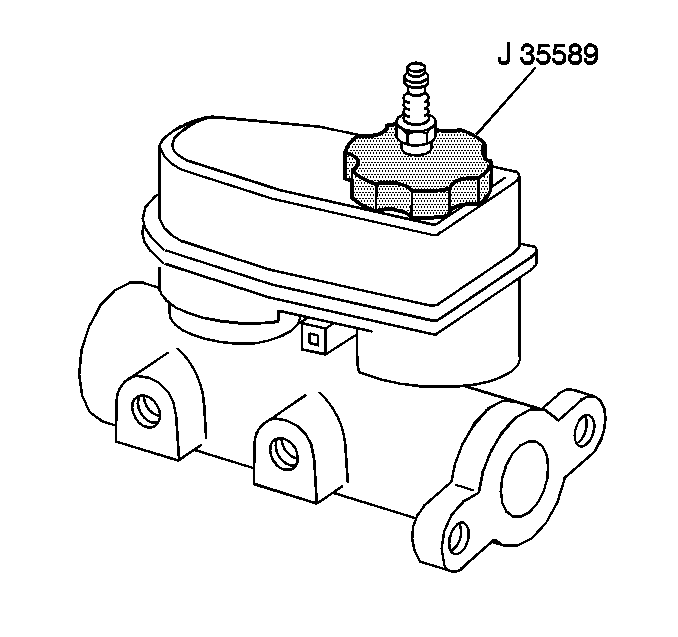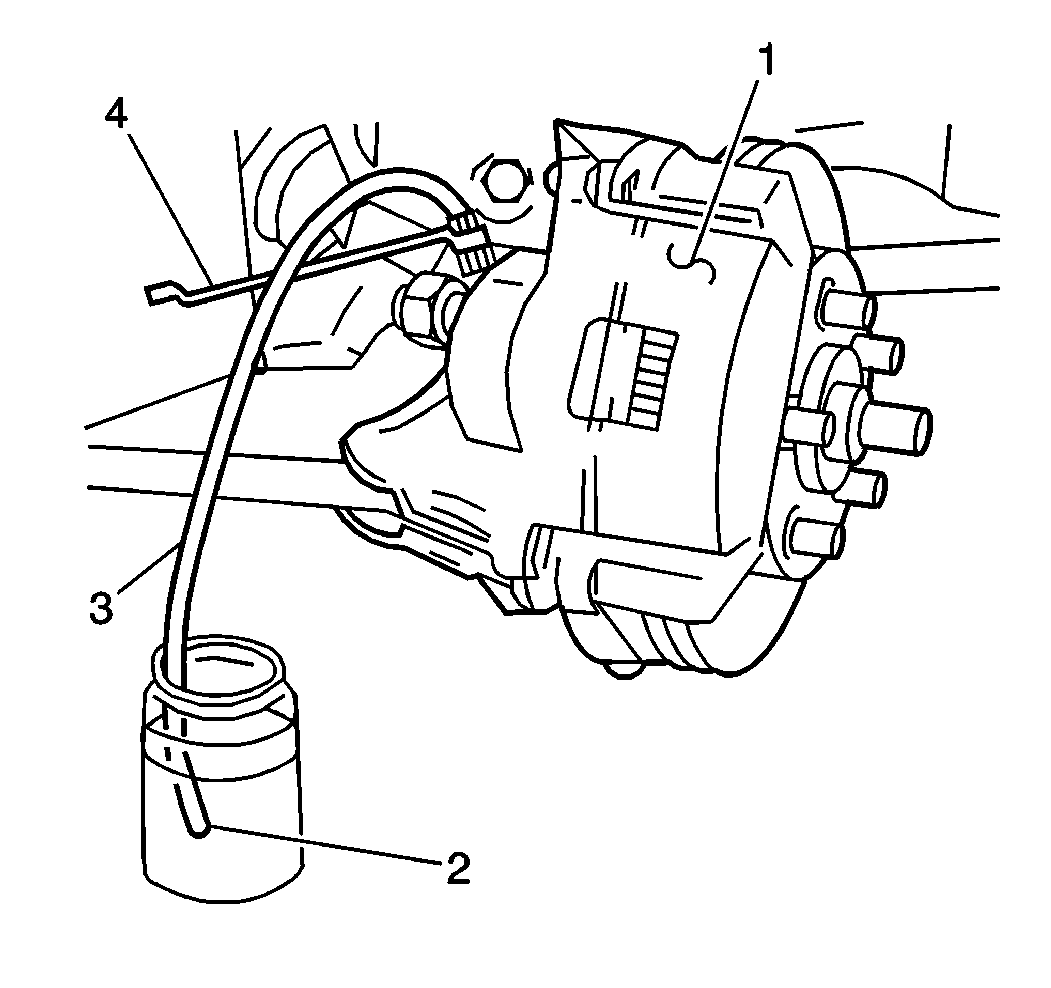Caution: Use only SUPREME 11 or equivalent DOT 3 brake fluid from a clean, sealed
container. Do not use fluid from an open container that may be contaminated
with water. Improper or contaminated fluid will result in damage to components
or loss of braking, with possible personal injury.
Notice: Pressure bleeding equipment must be of the diaphragm type. It must have
a rubber diaphragm between the air supply and the brake fluid to prevent air,
moisture, and other contaminants from entering the hydraulic system.
Notice: Avoid spilling brake fluid on any of the vehicle's painted surfaces,
wiring, cables, or electric connectors. Brake fluid will damage the paint
and the electrical connections. If any fluid is spilled on the vehicle, flush
the area to lessen the damage.
Pressure Flushing
Tools Required
| • | J 29532 Diaphragm
Type Brake Bleeder |
| • | J 35589 Compact
Brake Bleeder Adapter |

- Clean the brake fluid
reservoir cover and the surrounding area.
- Remove the brake fluid reservoir cover.
- Remove any remaining brake fluid in the reservoir.
- Fill the brake fluid reservoir with clean brake fluid. Refer to
Master Cylinder Reservoir Filling
.
- Install the J 35589
to the brake fluid reservoir.
- Connect theJ 29532
brake fluid hose to the bleeder adapter.
- Adjust the pressure bleeding equipment to 35-70 kPa
(5-10 psi) and wait for approximately 30 seconds in order
to ensure there is no leakage.
- Adjust the pressure bleeding equipment to 205-240 kPa
(30-35 psi).
- Raise and suitably support the vehicle. Refer to
Lifting and Jacking the Vehicle
in General Information.

- Flush the brakes in the
following sequence:
- Attach the bleeder hose (3) to the bleeder valve at each
wheel.
- Place the other end of the bleeder hose into a container (2)
in order to collect the draining brake fluid.
- Slowly open the bleeder valve and allow the fluid to flow.
- Close the valve when clean brake fluid begins to flow or at least
235 ml (8 oz) of fluid accumulates.
Tighten
- Tighten the front caliper bleeder valves to 13 N·m
(115 lb in).
- Tighten the rear caliper bleeder valves to 7 N·m
(62 lb in).
- Tighten the rear wheel cylinder bleeder valves, if equipped, to
7 N·m (62 lb in).
- Remove the bleeder adapter.
- Replace all of the following rubber components:
- Replace the brake pressure modulator valve. Refer to
Brake Pressure Modulator Valve Replacement
in Anti-Lock Braking System.
- Inspect the brake fluid level in the reservoir. Fill the reservoir
to the correct level if necessary.
- Install the brake fluid reservoir cap.
- Bleed the entire brake hydraulic system. Refer to
Hydraulic Brake System Bleeding
.
- Lower the vehicle.
Manual Flushing

Important: Use a suitable container and/or shop rags in order to catch fluid and
prevent the fluid from contacting any painted surfaces.
- Clean the brake fluid reservoir cover and the surrounding area.
- Remove the brake fluid reservoir cover.
- Remove any remaining brake fluid in the brake fluid reservoir.
- Fill the brake fluid reservoir with clean brake fluid. Refer to
Master Cylinder Reservoir Filling
.
- Install the brake fluid reservoir cover.
- Raise and suitably support the vehicle. Refer to
Lifting and Jacking the Vehicle
in General Information.

- Flush the brakes in the
following sequence:
- Attach the bleeder hose (3) to the bleeder valve at each
wheel.
- Place the other end of the bleeder hose into a container (2)
in order to collect the draining brake fluid.
- Slowly open the bleeder valve and allow the fluid to flow.
- Close the valve when clean brake fluid begins to flow or at least
235 ml (8 oz) of fluid accumulates.
Tighten
- Tighten the front caliper bleeder valves to 13 N·m
(115 lb in).
- Tighten the rear caliper bleeder valves to 7 N·m
(62 lb in).
- Tighten the rear wheel cylinder bleeder valves, if equipped, to
7 N·m (62 lb in).
- Replace all the following rubber components:
- Replace the brake pressure modulator valve. Refer to
Brake Pressure Modulator Valve Replacement
in Anti-Lock Braking System.
- Inspect the brake fluid level in the reservoir. Fill the reservoir
to the correct level if necessary.
- Install the brake fluid reservoir cap.
- Bleed the entire brake hydraulic system. Refer to
Hydraulic Brake System Bleeding
.
- Lower the vehicle.




